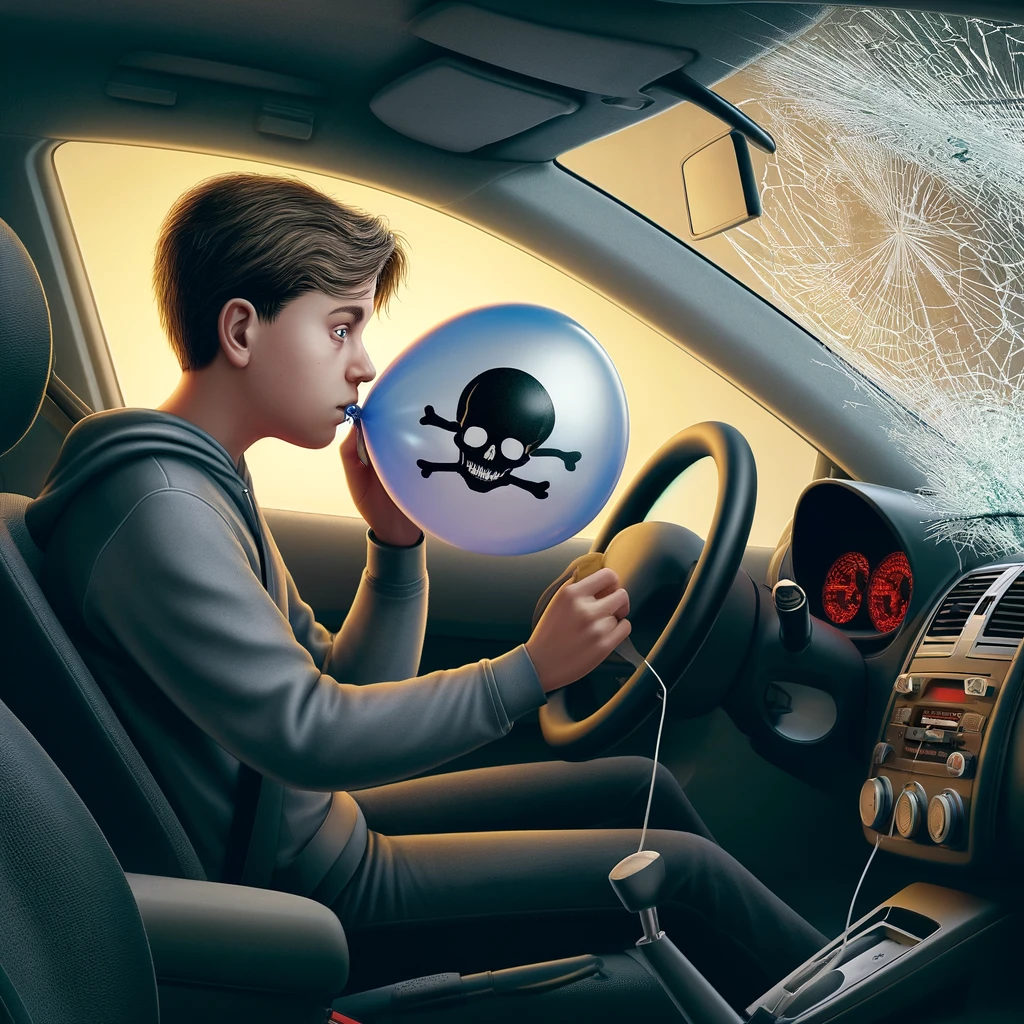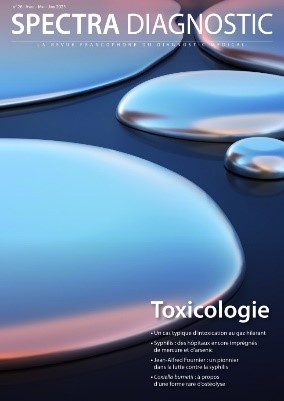Guillaume GRZYCH, Bruno MEGARBANE, Remy DIESNIS, Anthony CHAUVIN, Damien DENIMAL, Remy DIESNIS,
Emeline GERNEZ, Isabelle REDONNET-VERNHET, Justine BLIN, Isabelle KIM, Mickael BONNAN, Jean-Paul NIGUET,
Stéphanie BADIOU, Etienne MONDESERT, Nicolas FABRESSE, François PARANT, Apolline IMBARD, Agnès BOULLIER
For the SFBC Working Group "Biological management of nitrous oxide poisoning".
Abstract: This article highlights the importance of recognizing and addressing emerging hazards associated with the consumption of
nitrous oxide (N2
O), while highlighting the challenges in preventing road accidents linked to this consumption.
INTRODUCTION AND BACKGROUND
Road accidents and, more generally, road traffic accidents (RTAs), which include any event occurring on the public highway involving at least one vehicle and causing personal injury and/or material damage, represent a major public health problem worldwide. Every year, millions of people are injured or lose their lives in MVAs, with devastating consequences for individuals and society. Among the many factors contributing to these accidents (speed in particular), driving under the influence of psychoactive substances plays a major role. These substances, whether alcohol, narcotics or certain medications, significantly impair driving ability by modifying drivers' perception, reaction time and judgment. Drugs and alcohol are known to impair driving ability, increasing the risk of accidents. Alcohol reduces coordination and lengthens reaction time, while drugs such as cocaine and amphetamines can lead to impulsive and unpredictable behavior. Thanks to advances in biotechnology, highly sensitive and specific screening tests have been developed to detect these substances in bodily fluids, thereby contributing to road safety. Blood alcohol tests, as well as blood, urine and saliva analyses for various drugs, enable law enforcement agencies to control and punish drivers under the influence, thus contributing to public action in the fight against road insecurity, which is based on three strong strategic components: "prevention", "communication" and "repression". Two dead and one seriously injured in Saint-Thibéry (Hérault) in December 2021. Nitrous oxide (or laughing gas) and cannabis were responsible for the fatal accident. Four 615-gram bottles of nitrous oxide were found in the passenger compartment of the car. Shortly before the accident, the driver had posted a video on Snapchat while driving, showing the vehicle's occupants consuming nitrous oxide. This terrible incident, among others, illustrates the dangers of driving under the influence of nitrous oxide. Initially used in medical and industrial contexts, nitrous oxide is increasingly being diverted for recreational use, particularly among young people. Its ability to rapidly induce sensations of pleasure and relaxation makes it an attractive substance, but its effects on driving ability are alarming. Unlike alcohol and traditional drugs, nitrous oxide is very rapidly eliminated from the body, making it difficult to provide analytical proof of driving under the influence of nitrous oxide. In addition, the lack of strict regulations governing the sale and use of nitrous oxide facilitates its accessibility and misuse. Users can easily obtain gas cartridges or cylinders and consume them without worrying about legal consequences or road safety risks. This situation underlines the urgency of developing specific screening tests and strengthening laws to prevent nitrous oxide abuse and protect public safety. Although significant progress has been made in the detection of psychoactive substances or plants classified as narcotics, nitrous oxide represents a new challenge that requires increased attention. Research and development of new detection technologies, together with the introduction of appropriate regulations, are essential to meet this new challenge to road safety.
II - ACCIDENT-CAUSING SUBSTANCES
The use of psychoactive substances is a major risk factor in road accidents (1). Various substances, including alcohol, illegal drugs and certain medications, have deleterious effects on the cognitive and motor capacities of individuals, resulting in an increased risk of road accidents. The screening tests currently available are sensitive, specific and rapid, and their use is fully in line with road safety policy (Table I).
ETHANOL
Ethanol is one of the substances most commonly involved in road accidents. Alcohol affects the central nervous system, resulting in reduced coordination, longer reaction times and impaired judgment. To check that you have not exceeded the thresholds authorized by the Highway Code, ethanol is measured in your breath using an ethylometer (based on Henry's law: the constant ratio between the level of alcohol in your breath and the level in your blood is 1/2000), or in your whole blood (ethanolemia).
NARCOTICS
There are 2 stages in drug testing for driving: the screening procedure and the confirmation procedure. Screening tests are performed on saliva or urine. Confirmatory tests are performed on blood or saliva.
CANNABINOIDS
Cannabinoids are another category of substances frequently detected in drivers involved in road accidents. Tetrahydrocannabinol (THC), the main psychoactive compound in cannabis, alters perception of time and space, reduces motor coordination and slows reaction time. Cannabinoids are detected by Substances Effects and consequences on driving Screening / Dosage in the context of MVA or roadside prevention Alcohol Decreased ability to coordinate Increased reaction time Impaired judgment Exhaled air (Screening/Dosing) Blood (Dosage) Cannabinoids Impaired perception of time and space Reduced motor coordination Slower reaction time Urine and Saliva (Screening) Blood and Saliva (Dosage) Opiates (Codeine, Morphine, Heroin,...) Extreme somnolence Mental confusion Impaired motor coordination Methamphetamine and amphetamine Hyperexcitation Impulsive behavior Impaired judgment Cocaine Overestimation of abilities Increased risk-taking Impaired motor coordination Benzodiazepines Somnolence Muscle relaxation Impaired cognitive abilities Blood (Determination) mainly by urinalysis (11-Nor[1]9-carboxy-THC = THC-COOH), blood or saliva (THC), to determine the recent presence of this substance in drivers.
OPIACES
Opiates include substances such as heroin, morphine and drugs like codeine. These substances can cause extreme drowsiness, mental confusion and reduced motor coordination, making driving extremely dangerous. Tests for opiates are generally carried out by urine analysis, which detects the presence of morphine (the metabolic pathways of opiates lead to morphine).
AMPHETAMINES
Amphetamines (amphetamine/metham[1]phetamine and MDMA (=ecstasy), ...) are powerful stimulants which can cause hyperexcitation, impulsive behavior and a reduced ability to judge driving situations correctly. Although these substances increase alertness in the short term, their adverse effects on behavior and coordination can considerably increase the risk of accidents. The presence of these stimulants can be measured in urine and blood in routine practice.
COCAINE
Cocaine is another stimulant that can lead to overestimation of abilities, increased risk-taking and reduced motor coordination. Cocaine and its metabolites are mainly detected by analyzing derivatives (benzoylecgonine) in saliva or urine. Confirmatory assays are performed on a blood or saliva sample.
MEDICINES
Benzodiazepines, prescribed to treat anxiety and sleep disorders, can cause drowsiness, muscle relaxation and cognitive impairment. Their sedative effect can seriously compromise the ability to drive safely. Benzodiazepines are usually tested by urine analysis, to detect their presence and recent use. Detection of all these substances is essential for the implementation of effective road safety policies. Modern screening technologies can detect the presence of these substances with good sensitivity and specificity, and can be complemented by confirmatory chromatographic assays for absolute identification. These techniques thus provide crucial information for assessing the level of intoxication and the risk to road safety. However, new psychoactive substances continue to emerge (new synthetic products, nitrous oxide, etc.), requiring ongoing adaptation of screening methods to maintain road safety.
III - NITROUS OXIDE (N2 O): A NEW ACCIDENT-PRONE SUBSTANCE
MISUSE OF NITROUS OXIDE FOR RECREATIONAL PURPOSES
Nitrous oxide, historically used for its anesthetic properties in medicine and as a propellant in whipped cream siphons, has seen its use diverted to recreational purposes. Its ability to rapidly induce feelings of euphoria and relaxation has made it a popular substance among young people, often consumed at parties and social events (Figure 1) (2). This recreational use of nitrous oxide has become widespread due to its accessibility and misperception of its safety. Available in cartridge form for food use, it is easily diverted by consumers who inhale it directly from balloons inflated with the cartridges (Figure 1). Although perceived as harmless, this mode of consumption presents health risks, including neurological disorders and accidents due to impaired psychomotor skills. Over the years, nitrous oxide consumption patterns have evolved, with an increase in the use of large-volume containers (Figure 1) (3). Initially limited to small cartridges for cream siphons (around 6 g N 2 0), use has spread to industrial-sized nitrous oxide cylinders (650 g to 2 kg N 2 0). These large cylinders, often used in professional contexts, allow repeated inhalation of large quantities, exacerbating health risks. Festive events, such as music festivals and nightclub parties (Figure 1), have thus become prime locations for nitrous oxide consumption. The sale of balloons filled with the gas is commonplace, and participants may consume several balloons in a single evening, increasing the risk of overdosing and accidents. Inhalation of nitrous oxide in large quantities can lead to serious effects, such as functional vitamin B12 deficiency, nerve damage and cognitive impairment (4). Users are also exposed to immediate risks, such as loss of consciousness and accidents due to disorientation. Frequent use in large quantities increases the risk of dependence and permanent neurological damage (5) (Figure 2).
EPIDEMIOLOGY OF NITROUS OXIDE-RELATED ROAD ACCIDENTS
Recreational use of nitrous oxide is a growing trend, particularly among young people in France and Europe (aged 18-25). This rise in consumption is associated with an increased risk of road accidents. Studies carried out by various research and road safety institutes confirm this worrying trend. A survey conducted by the European Transport Safety Council (ETSC) in 2022 identified nitrous oxide as one of the emerging substances of greatest concern in terms of road safety (6). In France, recent data show an increase in road accidents involving nitrous oxide consumption. According to the Observatoire National Interministériel de la Sécurité Routière (ONISR), around 11% of serious accidents in 2023 involved drivers under the influence of psychoactive substances, including nitrous oxide (7). Law enforcement agencies are also reporting an increase in arrests for driving under the influence of this substance, particularly during night-time roadside checks in urban and suburban areas. On a European scale, the phenomenon is similar. The European Drugs Agency (EMCDDA) published a report in 2023 highlighting a significant increase in the recreational use of nitrous oxide and its involvement in road accidents. By 2022, it is estimated that nearly 7% of fatal accidents in Europe involved drivers who had taken nitrous oxide, either alone or in combination with other substances. The countries most affected include the Netherlands, Germany and the UK[1], where the availability and recreational use of this substance are particularly widespread. In the Netherlands, the number of road accidents involving nitrous oxide use was found to have increased by 80% between 2019 and 2021 (from 2,652 to 4,860 accidents) (8). The figures for road accidents involving nitrous oxide consumption in France and Europe highlight a growing problem, all the more so as these figures are probably underestimated. This underestimation is due to the difficulties of detection and diagnosis specific to this substance. Nitrous oxide is rapidly eliminated from the body, making it difficult to detect with standardized tests that can be used at roadside checks. Given the challenges of detection and diagnosis, further research and more effective measures to identify and prevent the abuse of this substance on the roads are crucial. In response to this increase, several initiatives have been launched to better understand and control nitrous oxide use on the roads. In France, awareness campaigns have been stepped up thanks to the joint action of the Hauts de France and Ile de France Regional Health Agencies (9). At European level, the European Federation of Clinical Chemistry and Laboratory Medicine (EFLM) has set up a network of experts to harmonize medical management strategies and screening protocols, in order to reduce accidents involving this substance.
EFFECTS OF NITROUS OXIDE ON DRIVING (FIGURE 3)
Dizziness and mental confusion: Nitrous oxide often causes feelings of dizziness and mental confusion. These effects can disrupt the driver's ability to concentrate on the road and react quickly to unexpected situations. The feeling of disorientation can also impair perception of the road environment, making it difficult to maintain appropriate steering and speed (10). Loss of coordination: One of the major consequences of nitrous oxide inhalation is loss of motor coordination. This affects the precise movements needed to drive a vehicle safely, such as turning the steering wheel, using the pedals and watching the mirrors. Reduced coordination increases the risk of loss of vehicle control, particularly in emergency situations (10). Increased reaction time: Nitrous oxide slows reflexes, lengthening the time needed to respond to imminent danger. This reduction in reaction time is particularly dangerous in high-speed driving or dense traffic environments, where decisions must be made in a fraction of a second (10). Euphoria and a feeling of power: The feeling of euphoria induced by nitrous oxide can lead to an underestimation of risks and to imprudent decision-making. Drivers may feel invincible and attempt dangerous maneuvers, such as driving at high speed, illegal overtaking or disobeying traffic lights (10). Cumulative effects and polyconsumption: nitrous oxide can be consumed in combination with other psychoactive substances such as alcohol or cannabis (11). This polyconsumption can exacerbate the negative effects of each substance, exponentially increasing road safety risks. The combination of these substances can lead to profound sedation, increased disorientation and an even greater reduction in driving ability.
RISKS AND CHALLENGES FOR ROAD SAFETY
Increased accidents: The cognitive and physical effects of nitrous oxide on drivers directly increase the risk of accidents. Difficult to detect: Unlike alcohol or other drugs, nitrous oxide is difficult to detect with standard toxicological tests. Its short half-life in the body means that it may no longer be present in body fluids during police checks, even if its effects persist.
Lack of knowledge and awareness: Many drivers, especially young people, are unaware of the dangers associated with inhaling nitrous oxide before getting behind the wheel. This ignorance increases the risk of consumption before driving, often in the mistaken belief that the effects are harmless or short-lived.
Inadequate regulation: Current laws on the use of nitrous oxide are often insufficient to prevent its abuse. In many countries, the substance is readily available and poorly regulated, making it easy to abuse, even before driving.
EFFECTS OF NITROUS OXIDE ON DRIVING BEHAVIOR: RECENT STUDY
Nitrous oxide is a popular recreational intoxicant, and associated equipment is increasingly found at road accident scenes, suggesting that N 2 O intoxication contributes causally to a significant number of road accidents (8). However, information on the pharmacodynamic and kinetic characteristics of N 2 O in recreational use is limited (3), thus hampering policy formulation and enforcement. A recent study conducted by Maastricht University in collaboration with the Netherlands Organisation for Applied Scientific Research (TNO) and Leiden University Medical Centre revealed that recreational use of nitrous oxide significantly impairs driving ability well beyond the period of immediate intoxication. Even after the initial euphoric effects have worn off, residual psychomotor alterations persist for at least 45 minutes, compromising road safety. The researchers tested promising measurement techniques in the laboratory, demonstrating the feasibility of detecting this substance in legal contexts. The study recommends further research[1] to determine precisely how nitrous oxide affects different facets of driving ability, and to establish threshold concentrations for roadside screening. These findings highlight the need to develop specific measuring instruments to improve road safety in relation to nitrous oxide use. However, apart from a summary of the study on the university website, no official scientific publication highlights the verified and published results of this study in early 2024 (12). Responses from an online survey of 511 N 2 O users revealed that the majority of participants inhaled N 2 O from party balloons filled with between 4 and 14 liters of the gas. Inhalation was generally done using a repetitive "re-breathing" technique, with 20-30 second pauses every six breaths, or without pauses, for a total of around 12 cycles. In addition, 10.3% of respondents admitted to inhaling N2 O while driving. Driving within an hour of inhalation was common, defining a relevant period for studying the psychomotor effects of recreational N2 O use in future research (13). However, in addition to a rapid screening test, it will be necessary to develop a reliable and robust biological confirmation test on a blood sample in order to ascertain the individual's actual biological exposure to nitrous oxide in relation to his or her psychoactive actions.
IV - CHALLENGES OF NITROUS OXIDE ROADSIDE TESTING
With the increasing recreational use of nitrous oxide, it is becoming imperative to develop specific and reliable screening tests for this substance, in order to prevent road accidents and protect public health. Testing for nitrous oxide on the roads presents several unique challenges in toxicology and medical biology. Unlike alcohol or other drugs, nitrous oxide is rapidly eliminated from the body, making it difficult to detect with standard roadside screening tests. Current methods, such as breath, blood or urine analysis, are not optimized for this substance, making it difficult to accurately identify intoxication at the time of the incident.
RAPID METABOLISM
Nitrous oxide is characterized by rapid metabolism and elimination, often within minutes to an hour after inhalation (3). This characteristic considerably reduces the window of time during which the substance is detectable in body fluids, posing a major challenge for law enforcement during roadside checks. As a result, a driver under the influence of nitrous oxide may no longer show detectable traces at the time of testing, despite a still present impairment in driving ability.
USING METABOLIC PARAMETERS FOR SCREENING
Screening for nitrous oxide consumption often relies on indirect screening by measuring metabolic parameters such as vitamin B12, homocysteine and methylmalonic acid, which are impacted by N2 O consumption. These biomarkers are therefore used to identify the biochemical effects of nitrous oxide exposure, which can inhibit the functions of methionine synthase and methylmalonyl-CoA mutase, vitamin B12-dependent enzymes (Figure 4). 2.1 Vitamin B12 Nitrous oxide oxidizes the cobalt atom in vitamin B12's structure, disrupting DNA synthesis and neuronal function. A vitamin B12 deficiency, detectable by a drop in serum concentrations, may indicate prolonged nitrous oxide consumption. However, the vitamin B12 assay lacks specificity, as a decrease in its concentration may be due to a variety of other medical conditions, such as gastrointestinal disorders or malabsorption. Moreover, nitrous oxide inactivates vitamin B12, which does not necessarily lead to a quantitative deficiency (14). 2.2 Homocysteine Nitrous oxide, by reducing the quantity of active vitamin B12, can lead to a reduction in the enzymatic activity of methionine synthase, for which the latter is the cofactor. As a result, plasma concentrations of homocysteine, the substrate of methionine synthase, may rise. However, elevated homocysteine concentrations may also result from dietary, genetic or other pathological factors, thus reducing the specificity of this biomarker for the detection of nitrous oxide abuse (15). 2.3 Methylmalonic acid Nitrous oxide, by reducing the amount of active vitamin B12, can lead to a decrease in the enzymatic activity of methylmalonyl-CoA mutase, for which the latter is the cofactor. As a result, plasma or urinary concentrations of methylmalonic acid, the substrate of methylmalonyl[1]CoA mutase, may increase. As with homocysteine, elevated levels of methylmalonic acid may be due to a variety of causes, including dietary deficiencies of vitamin B12 or hereditary metabolic diseases, limiting its use as a specific indicator of nitrous oxide consumption (16). Figure 4 Metabolic impact of nitrous oxide and plasma variations in metabolites of interest. Cb: Cobalamin, Co: Cobalt, THF: TetraHydroFolate, MMA: Methylmalonic Acid, SAH: S adenosyl homocysteine, SAM: S adenosyl Methionine
DIFFICULTIES ENCOUNTERED IN SCREENING
At present, there are no rapid screening tests available that can be performed at the "roadside" by law enforcement officers. As for laboratory tests (vitamin B12, total homocysteine, methylmalonic acid), they suffer from significant limitations: 3.1 Lack of specificity Although these metabolic parameters can provide clues to possible exposure to nitrous oxide, their lack of specificity poses a significant problem. Vitamin B12, homocysteine and methylmalonic acid levels can be influenced by many factors unrelated to nitrous oxide use, making it difficult to attribute these metabolic abnormalities directly to nitrous oxide consumption. Consequently, it is crucial to develop more specific screening methods to reliably identify nitrous oxide abuse, and to continue research to improve the accuracy of diagnostic tests. 3.2 Lack of standardized tests Currently, there are no standardized screening tests for nitrous oxide in road traffic situations. The tests used for other substances are not suitable for detecting the low residual concentrations of nitrous oxide after inhalation. The development of specific tests requires in-depth research to identify reliable biomarkers and develop rapid, accurate detection technologies (3). 3.3 Variability of effects The effects of nitrous oxide can vary considerably from one individual to another, depending on the dose inhaled, frequency of use and individual physiological characteristics. This variability further complicates the assessment of critical concentration levels that could be associated with significant impairment of driving ability. Medical biologists therefore need to work on establishing relevant screening thresholds that take account of these inter-individual variations. 3.4 Lack of knowledge and awareness Lack of awareness and training of healthcare professionals and law enforcement officers regarding the specific dangers of nitrous oxide is another major obstacle. Without adequate knowledge of the signs and symptoms of intoxication, it is difficult to suspect and confirm the use of this substance during roadside checks. Specialized training programs and awareness campaigns are essential to bridge this gap. The challenges of roadside testing for nitrous oxide highlight the need to step up research in medical biology to develop effective and reliable detection methods. The complexity of this task demands a multidisciplinary approach involving scientists, clinicians and law enforcement agencies, as well as significant investment in research and development of new screening technologies. Only concerted action will better protect road safety from the risks associated with nitrous oxide consumption.
V - CONTROL METHODS AND ASSOCIATED DIFFICULTIES
To combat the dangers of nitrous oxide at the wheel, several measures need to be considered:
DEVELOPMENT OF SCREENING TESTS
Invest in research to develop reliable, rapid screening tests for recent nitrous oxide consumption (driving under the influence), suitable for use in the field by law enforcement agencies. Two difficulties: - the very short half-life of nitrous oxide in the body, making its detection in a biological matrix very fleeting; - the use of a specific biomarker that would reflect recent rather than chronic consumption.
TRAINING AND AWARENESS-RAISING
Train health professionals and law enforcement officers in the specific dangers of nitrous oxide and in new screening methods. Raise awareness among the general public, especially young people, through information campaigns on the risks of using nitrous oxide before driving.
PUBLIC AWARENESS CAMPAIGNS
Launch awareness campaigns to inform the public about the dangers of driving under the influence of nitrous oxide. Use social media, TV commercials and educational programs to reach a wide audience and change misperceptions about the safety of this substance.
THE NEED FOR STRICT REGULATIONS
Changes in nitrous oxide consumption patterns and the use of ever-larger containers call for an appropriate regulatory response. The authorities need to step up controls on the sale and use of this substance, particularly for large containers. In addition, awareness-raising campaigns are essential to inform the public of the dangers associated with nitrous oxide inhalation, and measures must be taken to reduce the accessibility of this substance for recreational purposes. Introduce specific regulations to control the sale and use of nitrous oxide, particularly with regard to young people. These regulations could include restrictions on sales to minors, limits on quantities purchased and severe penalties for driving under the influence of the substance.
RESEARCH AND INNOVATION
Encourage ongoing research to better understand the long-term effects of nitrous oxide exposure and to develop innovative prevention and treatment strategies. This research must be multi-disciplinary, involving experts in biology, neurology, addictology, emergency medicine, etc. Nitrous oxide represents a growing danger to road safety, due to its psychoactive effects and the difficulty of detecting it. To prevent accidents involving this substance, it is therefore crucial to develop effective screening tests, raise public awareness and tighten regulations. By investing in research and innovation, we can better understand and manage the risks associated with nitrous oxide, thereby contributing to improved safety on our roads.
VI - CONCLUSION
Combating nitrous oxide consumption while driving requires an integrated approach involving research, education and regulation. The multiple challenges posed by this substance, notably its rapid elimination and the lack of specific screening tests, make further research imperative. It is therefore crucial to fund research to develop effective screening, diagnostic and monitoring methods, enabling rapid and accurate detection of nitrous oxide in road safety contexts. Education also plays a fundamental role. Educating the public, especially young people, about the dangers of nitrous oxide consumption is essential to reducing its recreational use. Awareness campaigns, educational programs in schools and training for health professionals and law enforcement officers are needed to disseminate accurate information and create a collective awareness of the associated risks. Regulations must be tightened to limit easy access to nitrous oxide, and to introduce strict controls on its sale and use. Authorities need to work with scientists to establish appropriate screening thresholds and roadside testing protocols. Specific legislative measures can include restrictions on the sale of large quantities of nitrous oxide, fines for inappropriate use and severe penalties for driving under the influence. Investing in these areas will not only improve road safety, but also protect public health by reducing incidents linked to nitrous oxide abuse. A coordinated approach backed by evidence-based policies can transform the way we tackle this emerging challenge. By mobilizing the necessary resources and implementing integrated strategies, we can significantly reduce road accidents associated with this substance and ensure safer roads for all.
VII - PROSPECTS AND ACTIONS
1. EXPERT GROUPS IN FRANCE
To respond effectively to the problem of nitrous oxide abuse, it is essential to set up multidisciplinary working groups. Under the aegis of the Société Française de Biologie Clinique (SFBC), a working group dedicated to the biological management of nitrous oxide intoxication has been set up. This multidisciplinary group (https://www.sfbc-asso.fr/ groupe-de-travail-prise-en-charge-biologique-des[1]intoxications-au-protoxyde-dazote/), brings together experts in medical biology, neurologists and emergency physicians to establish diagnostic and treatment strategies (17).
2. INTERNATIONAL COOPERATION
On an international scale, collaboration with the European Federation of Clinical Chemistry and Laboratory Medicine (EFLM) is crucial. The EFLM Scientific Committee has set up a working group on biomarkers of diagnosis, as detailed on their website (www.eflm.eu/site/ who-we-are/committee/science-committee/fu/ tfg-biomarkers-of-diagnosis). The aim of this group is to harmonize methods for the detection and management of nitrous oxide poisoning.
3. PROTOSIDE NETWORK
The recent creation of the PROTOSIDE network (www. protoside.com) (18), Plateformes et Réseaux pour l'Orientation, le Traitement et l'Organisation des Soins des Intoxications au N 2 0, Diagnostic et Education, marks an important step in the fight against nitrous oxide abuse. The network brings together professionals committed to a number of missions. The PROTOSIDE network focuses on raising public awareness, particularly among young people, of the dangers of recreational nitrous oxide use. It develops educational programs for healthcare professionals and participates in prevention campaigns organized by various bodies. PROTOSIDE creates and coordinates a national network of healthcare professionals - doctors, nurses, psychologists, etc. - specifically trained to respond effectively to cases of nitrous oxide poisoning. - specifically trained to respond effectively to cases of nitrous oxide poisoning. This network facilitates the exchange of knowledge and best practices between the various healthcare players. In collaboration with researchers, the PROTOSIDE network deepens knowledge of the effects of nitrous oxide and improves treatment protocols. This includes conducting clinical studies and publishing results to inform and guide clinical practice. PROTOSIDE works actively with policy-makers to strengthen legislation and control measures around the sale and use of nitrous oxide. The network is committed to advocating stricter public policies and the implementation of effective regulations to protect public health. The implementation of these perspectives and actions is essential in the fight against nitrous oxide abuse. By integrating research, education, professional collaboration and political advocacy, we can hope to significantly reduce the risks associated with this substance and improve road safety. The mobilization of the scientific community and public health authorities is crucial to achieving these goals and ensuring safer roads.










 Make a donation
Make a donation